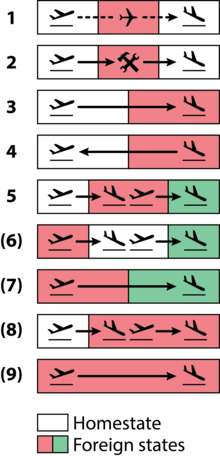Freedoms of the air
The freedoms of the air (Engl. Freedoms of the air ) are of the ICAO created proposals for air rights in commercial air transport. The individual rights are either mutually granted in bilateral agreements or they exist between states that have signed the transit or transport agreement.
development
Shortly after the Wright brothers' maiden flight in 1903, the first meetings were held on the experimental regulation of international and transnational overflight rights for airships and aircraft, although the participating states were unable to come to a joint agreement until the First World War. The Versailles Treaty of 1919 already knew in its German version "freedom to fly through and land" , which Article 200 of the treaty guaranteed allied airships and airplanes in German airspace until the final evacuation of Germany by Allied forces. In 1919 there was also the Paris Aviation Agreement, which laid down the first framework conditions for international and transnational aviation rights, on the basis of which, among other things, the International Commission for Air Navigation (ICAN) was founded in 1919 and 1922 to monitor airspace and overflight rights.
The first truly internationally binding, comprehensive and detailed standardized version of air rights goes back to the Chicago Agreement of 1944, when the ICAO was founded. The freedoms are regulated in additional agreements and not in the Chicago Convention itself. The 1st and 2nd freedoms are part of the transit agreement, while freedoms three to five are also regulated in the transport agreement. The remaining freedoms, however, are not stipulated in international treaties and are therefore only "so-called".
Freedoms 6, 7, 8 and 9 are comparatively rare in order to protect domestic markets from cheap competition from abroad. In the European Union , however, since April 1, 1997, full cabotage has been possible for all EU airlines , which includes the 8th and 9th freedom.
The nine freedoms of the air
The aviation freedoms that the contractual partners can grant themselves are currently differentiated into nine different situations:
| freedom | Description and example |
|---|---|
| 1. Freedom | Overflight: The airline can fly over a foreign country from its home country without landing there. z. B. Aeromexico AM 613: Calgary - Mexico City via US airspace |
| 2. Freedom | Technical stopover: Right to stopover in a foreign country for non-commercial purposes. z. B. Refueling stop |
| 3. Freedom | Direct transport (bring): Right to transport passengers or cargo from the airline's home country abroad. z. B. Lufthansa LH 1346: Frankfurt - Warsaw |
| 4. Freedom | Direct transport (pick up): Right to transport passengers or cargo from abroad to the home country of the airline. z. B. Lufthansa LH 1353: Warsaw - Frankfurt |
| 5. Freedom | Transportation of passengers or freight between two foreign countries, with either the starting point or the end point of the journey being in the home country. z. B. Emirates EK 412: Dubai - Sydney - Christchurch |
| So-called 6th freedom | Transportation of passengers or freight between two foreign countries with a stopover in the home country. z. B. Air Tahiti Nui TN 102: Auckland - Papeete - Los Angeles |
| So-called 7th freedom | Transportation of passengers or freight between two foreign states without the route touching the home state. z. B. Ryanair FR 1143: Lisbon - Berlin |
| So-called 8th freedom | Consecutive cabotage : An airline carries passengers or cargo within another country on a flight that started or will end in the home country. z. B. Air France AF 154: San Francisco - Newark - Paris , with passengers also being transported between San Francisco and Newark. |
| So-called 9th freedom | Independent cabotage: An airline carries passengers or cargo within another country without touching another country. z. B. Easyjet EZY5500: Düsseldorf - Berlin |
Web links
- FOCA : The Freedoms of Aviation as PDF
- Transit Agreement of 1944 as PDF (en)
- Transport agreement from 1944 as PDF (en)
